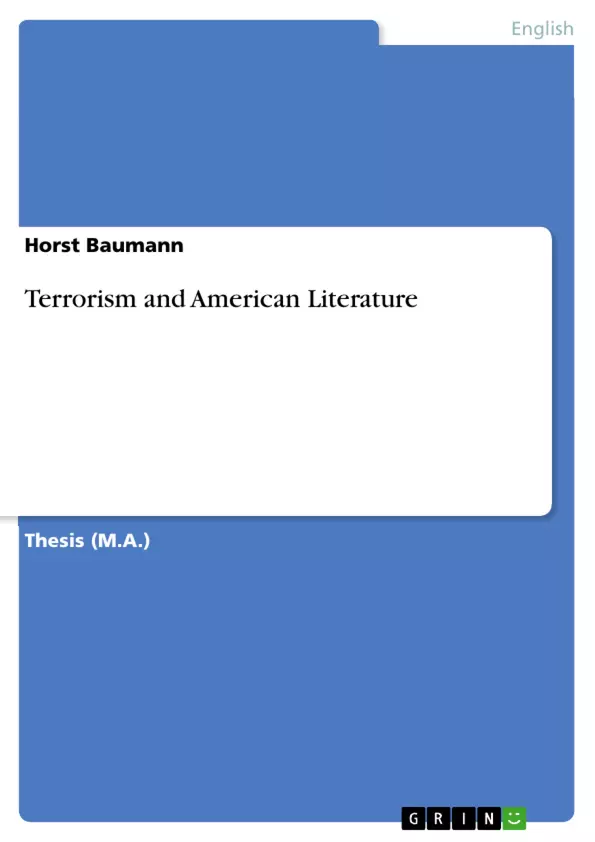In his essay "'God save us from the bourgeois adventure': The
Figure of the Terrorist in Contemporary American Conspiracy Fiction"
(1996), written in the aftermath of the 1993 attack on the World Trade
Center, Steffen Hantke remarks how quickly politicians, the media, and
the public at that time agreed that the bombing had to be understood as
part of a larger confrontation between Western democracies and 'Islamic
Fundamentalism' (for the following comp. 1996: 219-222). He goes on to
argue that the then newly discovered enemy 'Islamic terrorism' had filled
the vacancy in the collective political imagination that was left by the
demise of Communism in the late 1980ies, and that this new conflict
continued the kind of cultural paranoia that had sustained the historical
narrative of the Cold War era. Hantke describes cultural paranoia as the
effect of a cultural machinery that amalgamates complex political contexts
and historical developments into homogeneous and larger-than-life
cultural abstractions against which the collective political imagination can
construct itself as a unified entity. In other words, cultural paranoia
creates a sprawling narrative of the nation/the American way of
life/Western civilization under threat that legitimizes state power, ensures
compliance with dominant social norms and unifies the nation by
stigmatizing dissent as treason.
Inhaltsverzeichnis (Table of Contents)
- Introduction - The Age of Terrorism
- 1. Don DeLillo's Mao II – The 'zero sum game' of novelists and terrorists
- 2. Postmodernism, late capitalism, and art
- 2.1. Postmodernism as aesthetic project and historical epoch
- 2.2. Jameson: Postmodernism as the logic of late capitalism
- 2.3. Late capitalist culture
- 2.4. The loss of the "Real"
- 2.5. Postmodernism as a cultural dominant
- 3. Postmodernism as a cultural dominant in Mao II
- 4. The writer
- 4.1. Postmodern mass culture and the culture industry
- 4.2. Bill's modernist view of art
- 5. The terrorist
- 5.1. The terrorist as spectacular author
- 5.2. Spectacles of violence
Zielsetzung und Themenschwerpunkte (Objectives and Key Themes)
This work aims to analyze the portrayal of terrorism in contemporary American literature, specifically focusing on Don DeLillo's novel "Mao II." It explores how the novel reflects the cultural paranoia that permeates American society in the post-9/11 era, examining the interplay between terrorism, postmodernism, late capitalism, and the role of the writer in this context.- The construction of 'Islamic Terrorism' as a cultural construct and its role in shaping public opinion and legitimizing state power.
- The impact of postmodernism and late capitalism on American culture and the representation of terrorism within this framework.
- The role of the writer and the media in perpetuating and challenging cultural paranoia surrounding terrorism.
- The relationship between terrorism and violence as spectacles in a postmodern society.
- The novel's exploration of the "zero sum game" between novelists and terrorists in a world dominated by violence and media spectacle.
Zusammenfassung der Kapitel (Chapter Summaries)
The introduction examines the emergence of 'Islamic Terrorism' as a cultural construct in the wake of the 1993 World Trade Center bombing and its continued relevance in the post-9/11 era. It argues that the concept of 'Islamic Terrorism' serves as a tool for legitimizing state power and consolidating national identity by fostering a culture of fear and paranoia. Chapter 1 focuses on Don DeLillo's "Mao II" and its depiction of the "zero sum game" between novelists and terrorists in a postmodern world. This chapter explores the novel's portrayal of the writer's struggle to find meaning and relevance in a society saturated with violence and media spectacle. Chapter 2 examines the influence of postmodernism and late capitalism on American culture, exploring the impact of these forces on the understanding and representation of terrorism. This chapter delves into the concepts of postmodernism as a cultural dominant and the loss of the "Real" in a hyper-mediated society. Chapter 3 analyzes how postmodernism manifests as a cultural dominant in "Mao II." This chapter examines the novel's depiction of the media's role in shaping public opinion and how the terrorist becomes a spectacle, an object of fascination and fear. Chapter 4 focuses on the writer's role in the context of postmodern mass culture and the culture industry. It examines the contrasting views of art held by the protagonist, Bill, who represents a modernist perspective, and the postmodern world he inhabits. Chapter 5 explores the figure of the terrorist in "Mao II," analyzing the novel's portrayal of the terrorist as a spectacular author who uses violence to gain attention and power. This chapter examines the novel's critique of the media's role in sensationalizing terrorism and contributing to a culture of violence.Schlüsselwörter (Keywords)
This work explores the complex relationship between terrorism, postmodernism, late capitalism, and the American cultural imagination. It analyzes the construction of 'Islamic Terrorism' as a cultural construct, the impact of postmodernism on the representation of terrorism in literature, and the role of the writer and the media in shaping public opinion. Key terms include: cultural paranoia, postmodernism, late capitalism, media spectacle, terrorism, violence, and the writer.- Quote paper
- Horst Baumann (Author), 2003, Terrorism and American Literature, Munich, GRIN Verlag, https://www.grin.com/document/113099



